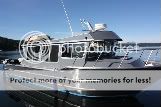I found this paper on the web. Gives a pretty good explanation of the problems with ethanol. FYI
The Negative Affects of Ethanol on Recreational Boat Fuel Systems
The National Marine Manufacturers Association (NMMA) opposes the use of marine fuels that contain greater than 10% ethanol content by volume. This position is based on safety and durability concerns and supported by many well documented studies.
According to state boating registrations, there are over 12 million recreational boats in the United States. Boat builders utilize five types of materials to fabricate fuel tanks. These are aluminum, steel, cross-link polyethylene, high density polyethylene and fiberglass. For a rough estimate of today’s numbers, there are approximately four million boats that have aluminum fuel tanks; approximately seven million have steel or polyethylene tanks, and less than one million have fiberglass tanks. The data clearly indicates that the increased use of ethanol in gasoline has raised safety and durability issues for aluminum and fiberglass fuel tanks.
Aluminum Fuel Tanks
In the case of aluminum tanks, aluminum is a highly conductive metal that relies on an oxide layer for its corrosion protection properties. Low levels of ethanol, such as E10 (10%), are usually not a problem in aluminum tanks because the oxide layer provides a good measure of protection. The problem occurs when the ethanol content is increased.
There are two mechanisms that occur with ethanol. Both mechanisms are a result of the hydroscopic property of ethanol, meaning it absorbs water. The more ethanol in the fuel, the more water there will be in the fuel tank. Water not only causes the tank to corrode, it also causes the corrosion particles to clog fuel filters, fuel systems, and damage engine components. The corrosion rate can be accelerated under a number of conditions if other contaminating metals are present such as copper which may be picked up from brass fittings or as a low level contaminant in the aluminum alloy. Chloride, which is a chemical found in salt water, will also accelerate corrosion. In the long term, corrosion can perforate the aluminum to produce leaks that would cause fuel to spill into the bilge and end up in the environment. In the worse case it could cause a fire and/or explosion hazard. Boat fuel tanks are often located under the deck next to the engine where the operator might not be aware of a leak until it was too late. .
The second mechanism that can occurs with the increased use of ethanol based fuel in aluminum tanks is galvanic corrosion. Gasoline fuel is not conductive, but the presence of ethanol or ethanol and water will conduct electricity. The galvanic process that occurs to aluminum trim tabs, stern drives, shaft couplings, etc. will occur within the aluminum fuel tank. Boat builders are able to protect exterior aluminum boat equipment with sacrificial anodes known as zincs. Sacrificial anodes are not a feasible option for the interior of a fuel tank.
Fiberglass Fuel Tanks
NMMA is in the early stage of evaluating the effects that ethanol in gasoline has on fiberglass tanks. Boat U.S., the boater advocacy association, recently issue a consumer alert reporting that owners of older yachts have experienced leaking fiberglass fuel tanks. There have also been reports of heavy black deposits on the intake valves of marine engines resulting in bent push rods, pistons and valves. Some of the preliminary analysis conducted by an independent lab found the deposits to be di-iso octyl phalate, a chemical found in the resin, gel coat and filler used to make fiberglass fuel tanks.
An initial theory is that when ethanol is introduced to the fuel tank the very small ethanol molecules diffuse into pores between the resin where they dissolve the unreacted phalates. Since the phalates are in solution they are able to pass through the fuel line filters. These phalates have exceptionally high temperature stability and remain intact when the fuel evaporates in the carburetor or undergo only partial decomposition in the combustion chamber thus creating the heavy black deposits on the engine’s intake valves.
Unlike aluminum, NMMA has yet to identify the effect that ethanol in fuel has on the tanks integrity or even the root cause of dissolved phalates. The theory is that it is being caused by ethanol and we know that ethanol dissolves phalates, but more testing is currently being conducted.
Conclusion
As stated in the opening paragraph, the NMMA has serious safety and durability concerns with the incremental increase in ethanol content in gasoline motor fuel. The majority of marine engines in use today are open loop systems that are designed, engineered and calibrated at the factory to operate with fuel containing either 10% MTBE or ethanol. Changing the fuel that these engines were designed, engineered and calibrated for will negatively effect drivability, exhaust and evaporative emissions, and potentially damage the components.
While these issues are significant, the boaters have a far more serious issue. The available data indicates that aluminum and fiberglass fuel tanks and butyl rubber fuel hoses that are currently being used will fail if the ethanol content is increased to 20%. That is not an emissions issue; it is not a drivability or durability issue. It is an issue that needs to be taken far more seriously. It is a threat to the health and safety of the boaters in your state.


